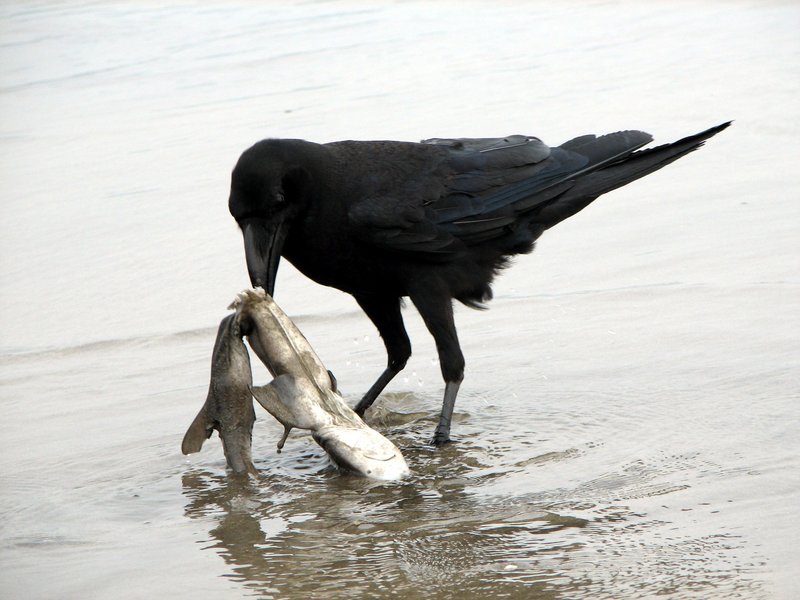| 새로운 사진 | 신문속의 동물소식 | 신기한 동물이야기 | 동물의 소리 | 동물동화상 | 사진 올리기 | 사진 저작권 | English |
|---|
| 재미있는 동물사진 | 괴수/괴어/엽기 동물사진 | 동물이름사전 | 동물목록 | 바깥고리 | 창고입구 | 똑똑누리집 |
|---|
| 이미지 정보 | Original File Name: Raven_scavenging_on_a_dead_shark-Jungle Crow (Corvus macrorhynchos).jpg Resolution: 2592x1944 File Size: 816418 Bytes Upload Time: 2007:12:03 10:10:34 | |
| 올린이 | 이름 (메일주소): Unknown | |
| 사진 제목 | Jungle Crow (Corvus macrorhynchos) - Wiki | |
 |
| Email : 카드 | 올린이 | 운영자 사진삭제 정보수정 Admin |
| 설명 | Jungle Crow (Corvus macrorhynchos) - Wiki
Jungle Crow
The Jungle Crow (Corvus macrorhynchos), or Indian Corby, is a very widespread Asian species of crow. They are very adaptable and are able to survive on a wide range of food sources making them capable of colonizing new areas due to which they are often considered a nuisance, especially on islands. They have a large bill and due to this they are also sometimes called Large-billed Crow or Thick-billed Crow. Description The overall size (46-59 cm in length) and body proportions vary regionally. In the far northeast in Japan, the Kuriles and the Sakhalin peninsula, it is somewhat larger than the Carrion Crow, while the form from India in the southwest of its range is appreciably smaller than the Carrion crow. All forms have a relatively long bill with the upper one quite thick and arched, making it look heavy and almost Raven-like. Generally, all forms have dark greyish plumage from the back of the head, neck, shoulders and lower body. Their wings, tail, face and throat are glossy black. The depth of the grey shading varies across its range to almost black in the Indian form. Distribution and habitat The range of this species is extensive and stretches from the northeastern Asian seaboard to Afghanistan and eastern Iran in the west, and south to India down to the Malaysian peninsula in the southeast. The Philippines also have a regional form. It occurs in woodland, parks and gardens, cultivated regions with a least some trees, but is a bird of more open country in the south of its range where it is not in competition with the Raven and Carrion Crow of the north. Behaviour Diet Extremely versatile in its feeding, it will take food from the ground or in trees. They feed on a wide range of items and will attempt to feed on anything appearing edible, alive or dead, plant or animal. It is also one of the most persistent species and is quite bold, especially in urban areas. It is well known for its regular habit of killing domestic Chickens, more so than any other species of Crow. In Japan, feral crows are considered to be a pest for ripping open garbage bags and taking wire coat hangers for their nests. Nesting The nest is a platform of twigs, usually high up on a tree with a preference for tall Conifers like Fir or Pine. There are normally 3-5 eggs laid and they are incubated for 17-19 days. The young are fledged usually by about the 35th day. In India, the various races of the Jungle Crow breed from March to May, but in the plains some of them start even in mid December. The nest is built in a fork of a tree, and is a shallow cup of sticks, sometimes neat and well made, sometimes sketchy and ragged ; it is lined with grass roots, wool, rags, vegetable fibre, and similar materials. Some nests have been found to be built partly or exclusively of wire. The normal clutch consists of four or five eggs, and rarely six or seven. The egg is a broad oval, rather pointed at the smaller end. The texture is hard and fine and there is a fair gloss. The ground-colour is any shade of blue-green, and is blotched, speckled and streaked with dull reddish-brown, pale sepia, grey and neutral tint. In size the eggs average about 1.45 by 1.05 inches. The Jungle Crow can serve as a host for the Asian Koel. Roosting Gregarious at roosts with many thousands at some roost sites. Large flocks may be seen at dusk arriving at major roost sites. These roosts show no apparent reduction even during the breeding season, and this is because they do not breed during their first year. Voice The voice is similar to the House Crow with which it is closest to, but deeper and usually more resonant and described as the usual loud "caaa-caaa-caaa". However it makes a range of calls, some which could be described as "cau cau" and others that could be mistaken for a woodpecker drumming. http://en.wikipedia.org/wiki/Jungle_Crow
| |||
| 저작권 정보 | 사진의 저작권은 원저작자에게 있습니다. 동물그림창고는 동물관련 사진을 전시할 수 있는 공간만을 제공합니다.사진을 사용하고자 할 경우에는 저작권자와 협의하시기 바랍니다. |
|
|
|
| |||||||
| CopyLeft © since 1995, 동물그림창고. All rights may be reserved. | ||||||||
Stats